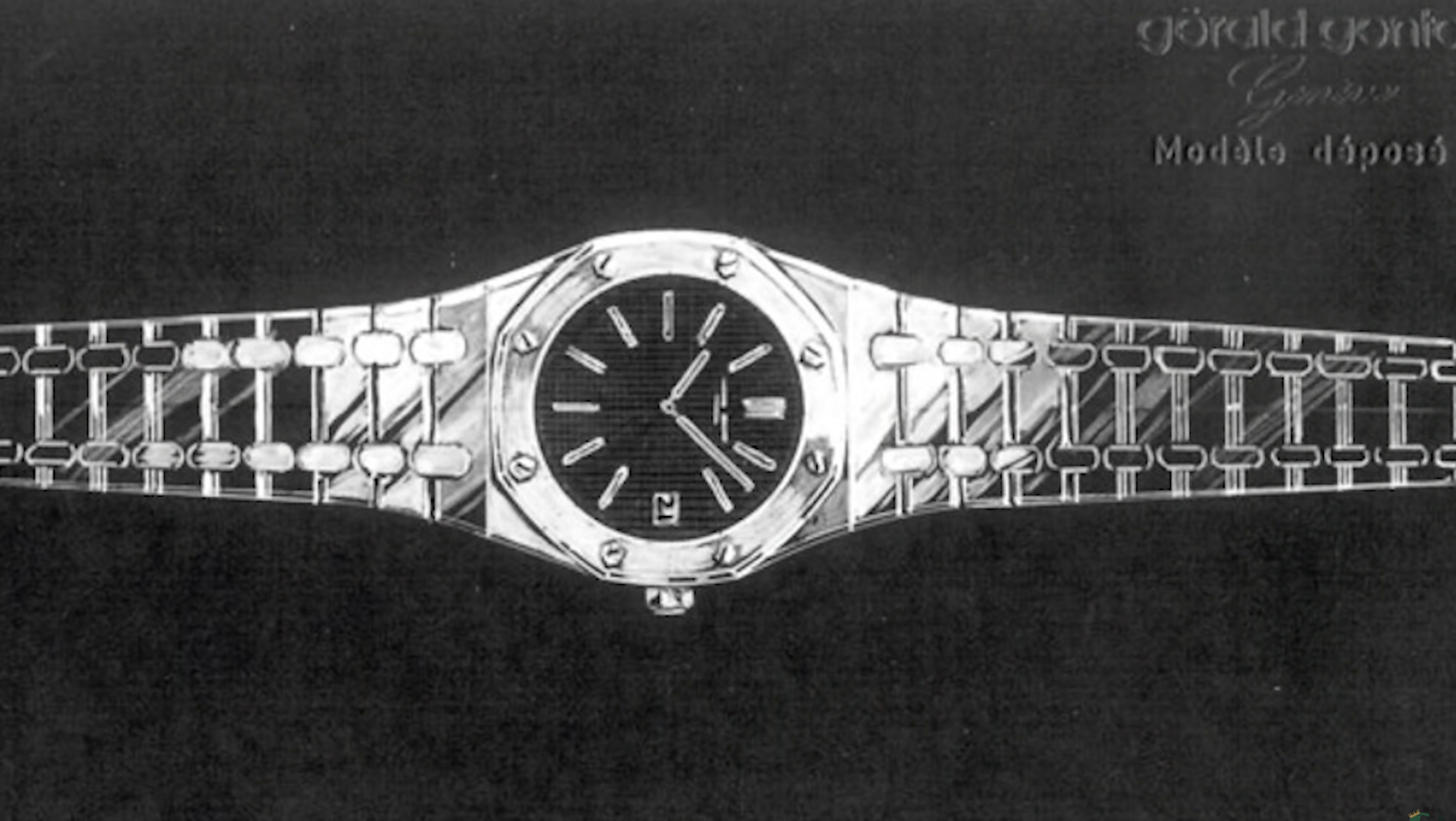
Audemars Piguet Royal Oak ‘Jumbo’
Few people know that the Royal Oak was in some way commissioned by AP’s importer of the brand in Italy: Alessandro De Marchi. In 1970, he advised Georges Golay (the director at that time) to come up with an unprecedented watch. Unlike anything in the classic history of the brand. Here is where the famous Gerald Genta comes in to play to design one of the most iconic timepieces history has to offer, as this model changed not only the face of the brand but the entire watch market. As it is the 50 Year anniversary of the Royal Oak, we have a look at their most important line: the “Jumbo Ultra-Thin”.
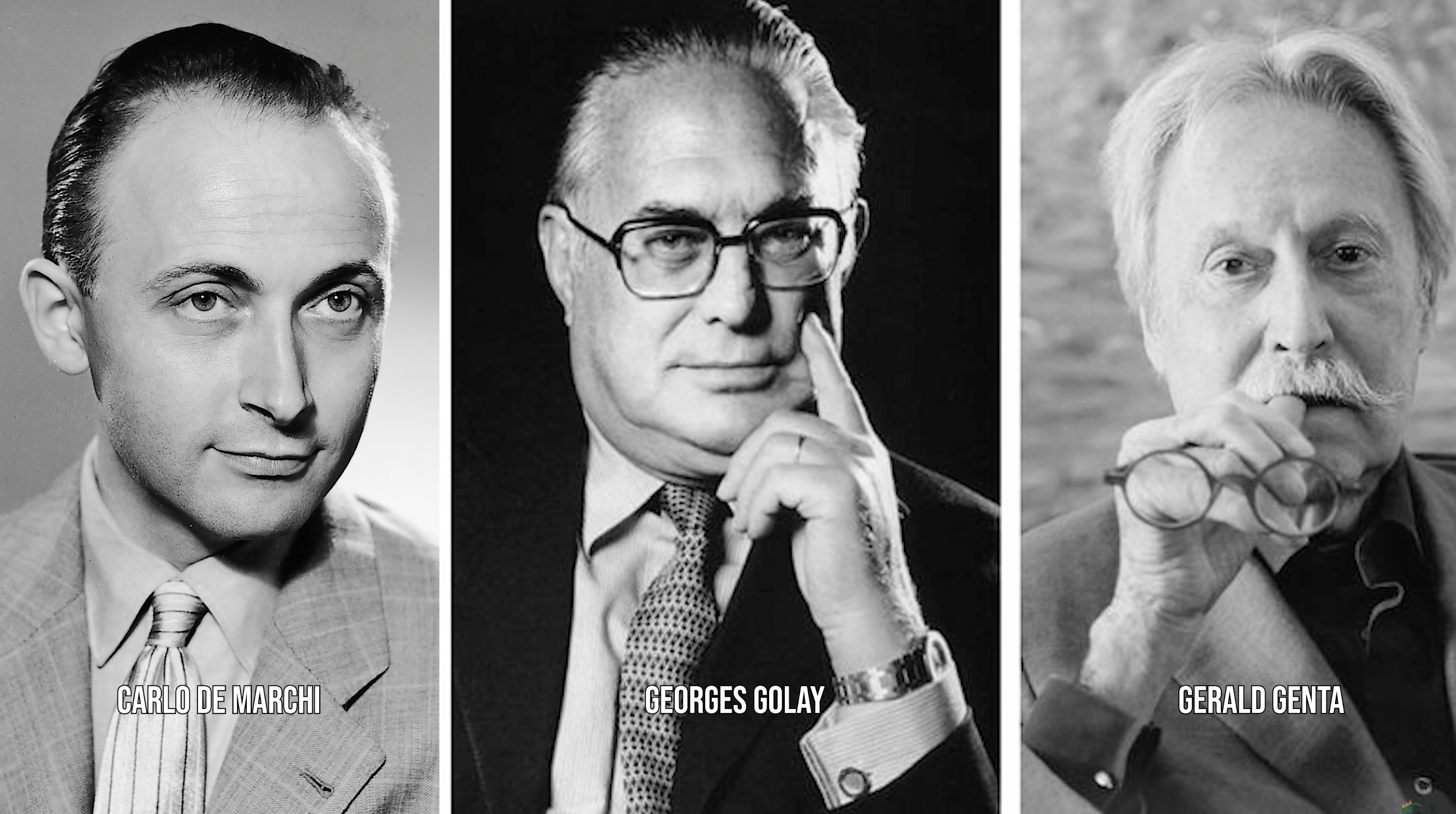
History
The family-owned company approved Genta’s design, despite the negative opinion of the conservative Mr. Jacques-Louis Audemars. But what did the market think of it when it was finally launched after a complicated production process, that lasted over a year due to manufacturing setbacks? At the 1972 Basel fair it was met with marvel but most industry insiders remained sceptic. The design might have been too futuristic and it definitely didn’t fit the distinguished maison d’horlogerie from Le Brassus; an oversized sports watch in steel is more something for Rolex. But another baffling fact: it commanded three times the price of a Submariner. Quite funnily emphasized by one of their marketing slogans: “It takes more than money to wear the Royal Oak”. It definitely caused an uproar as the most expensive steel watch. Some experts even predicted that the Royal Oak would put Audemars Piguet out of business and here’s why. Although the initial run only contained a thousand examples, it took half the production capacity of AP’s atelier in the early 70’s. Not only was the process painstaking, as mentioned before, the brand only created a total shy of six thousand wristwatches a year. Quite a big gamble, but boy did it pay out…
Design
Throughout the years Audemars Piguet kept true to a couple design features regarding the production of their most iconic Royal Oaks: the “Jumbo Ultra-thin”.
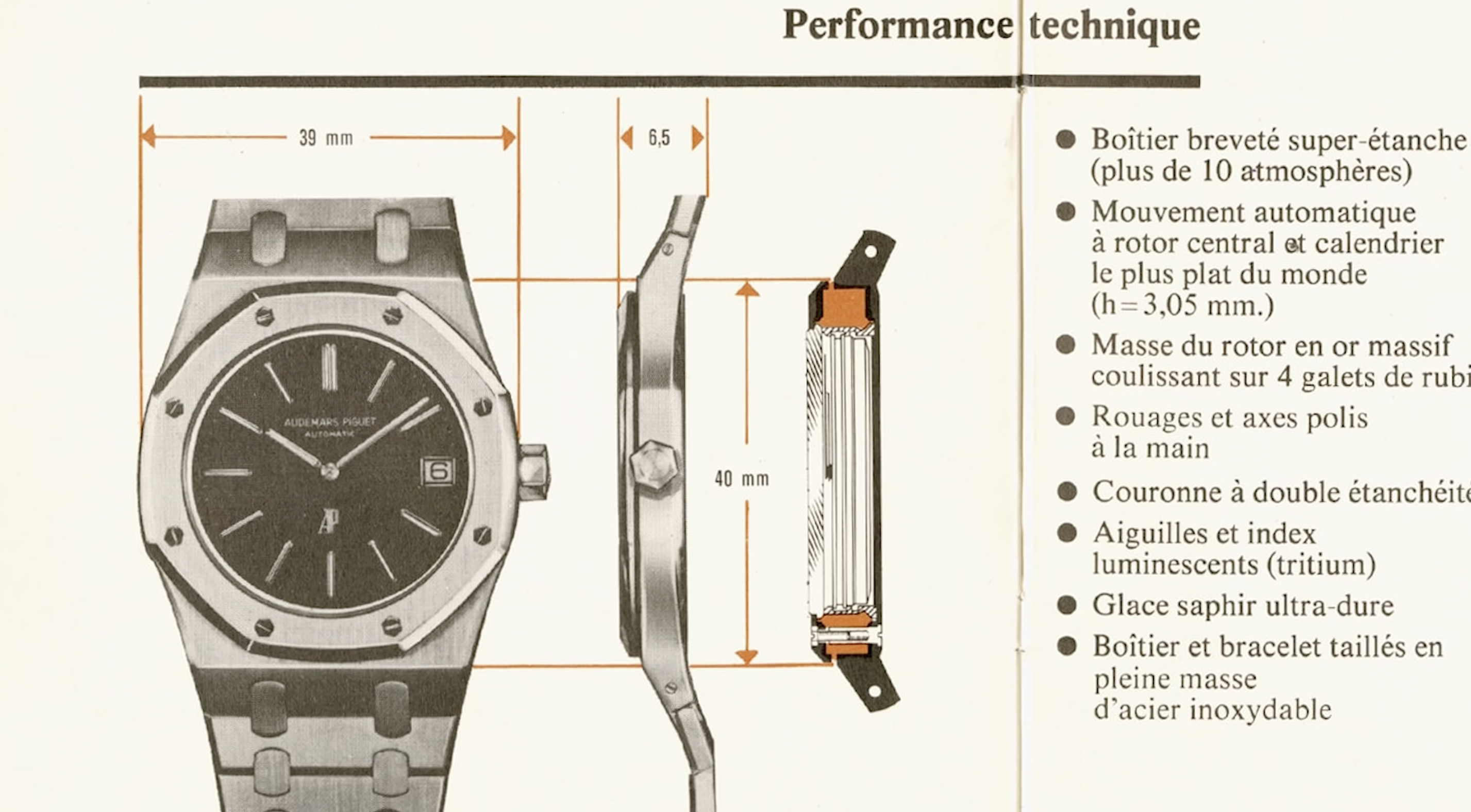
Case & Bezel
Let’s start with the case. As the nickname implies, we are talking about a large yet very thin watch. Without the crown the case measures close to 39mm (uncommonly large at the time of introduction) whilst only being 7mm thick. For the angular, octagonal bezel and the circular case Genta found inspiration in an old-fashioned diver helmet. The manufacturer Favre & Perret created a so-called “Monoblock”-case, meaning the movement is installed from the front-side rather than from the back. The bezel is fixed by eight bolts running through the case that are secured to the back by a round nut. The slots in the bolts on the front side are merely decorative and line out a perfect circular shape, that plays a visual game with the hexagonal bolt heads and the octagonal bezel. Another interesting feature can be seen from the side of the case as the rubber o-ring, to secure its water resistance, is left visible. The bolts and facets are polished and in contrast with the satin-finished bezel and case.
Crown
A small but important feature is the crown, again the hexagonal shape that we can also find in the bolts. Besides the look, it plays a significant role to ensure the water-resistance by using a screw-down mechanism similar to the Oyster construction from Rolex.
Bracelet & Clasp
Another recognizable and innovative feature is the integrated bracelet. The structural complexity didn’t stop at the case, as the bracelet has individually manufactured links to achieve a tapered shape. Initially created by the famous Gay Freres, the repeating pattern of two vertical connecting links would become iconic in its own right. The surface of the bracelet is satin-finished and the chamfers are polished, giving a both robust and sporty, yet elegant look. To ensure the right size for the wearer, the links nearest to the folding clasp are removable by screws.
Dial & hands
To create this decorative dial, they used a labor-intensive method were a guilloche machine reproduces a motif attached by a disc. Resulting in a carpet-like effect with a multitude of small squares in relief. The 3D effect, emphasized by the geometric symmetries, gives it a real futuristic look. But the irregularities of the dial surface caused problems with pad-printing the scripts. It took 18 failed attempts for the artisans at Stern to create the perfect “Grand Tappiserie” dial. Generally, the markers and AP logo are applied on the dial in the same material as the case. The slim shape and plain design of the hands are known as “baton” and the hour hand almost reaches the painted minute track whilst the minute hand is way shorter.
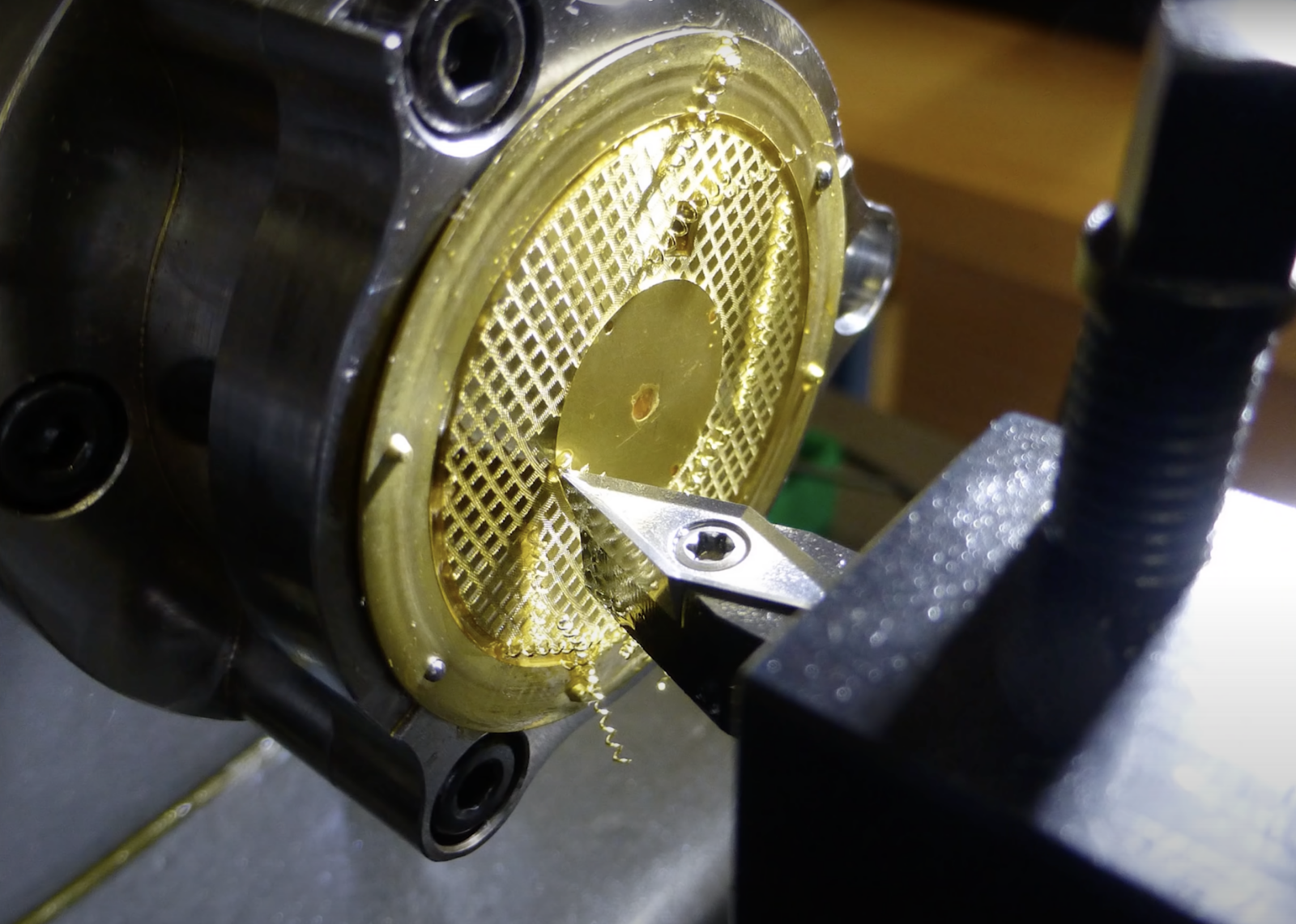
Movement
The beauty isn’t limited to the outside. If we take a look “under the hood” we find the thinnest automatic movement with a central rotor ever made: the cal. 920 produced by Jaeger-LeCoultre. This caliber is exclusively used by “The Holy Trinity”. (Audemars Piguet, Patek Philippe & Vacheron Constantin). After AP’s finishing its regarded as the caliber 2121. It houses a module for the date at 3 o’clock position and central hour and minute hand, no seconds hand. It has an approximate power reserve of 40 hours. It is very unique that AP sticked to the same movement for half a century; never change a winning team I guess.
With some exceptions we will highlight later on, AP sticked to previously mentioned aspects on all following references. We will take a look at them in chronological order. Starting in 1972 with reference 5402.
5402
The initial run of the Royal Oak consisted of 1000 examples, numbered on the caseback with the letter A in front of it. The sale of these thousand examples took slightly over a year and subsequently another 1000 “A-series” were produced. The A-Serie is considered the very grail as it is the first execution ever. Two types of dials are known, either with 30 or 32+ rows of squares, both having the AP logo at the 6 o’clock position. Not necessarily unique to the early examples, since the following B and C-series -both produced in a series of thousand pieces each- also possibly had the logo positioned at the bottom of the dial. The last batch was introduced in 1976 under the letter “D”. The D-series and 2nd half of the C-series had the AP logo at the 12 o’clock position. These later variants also had “AP” stamped on the fliplock instead of the full brand name we find on earlier examples.
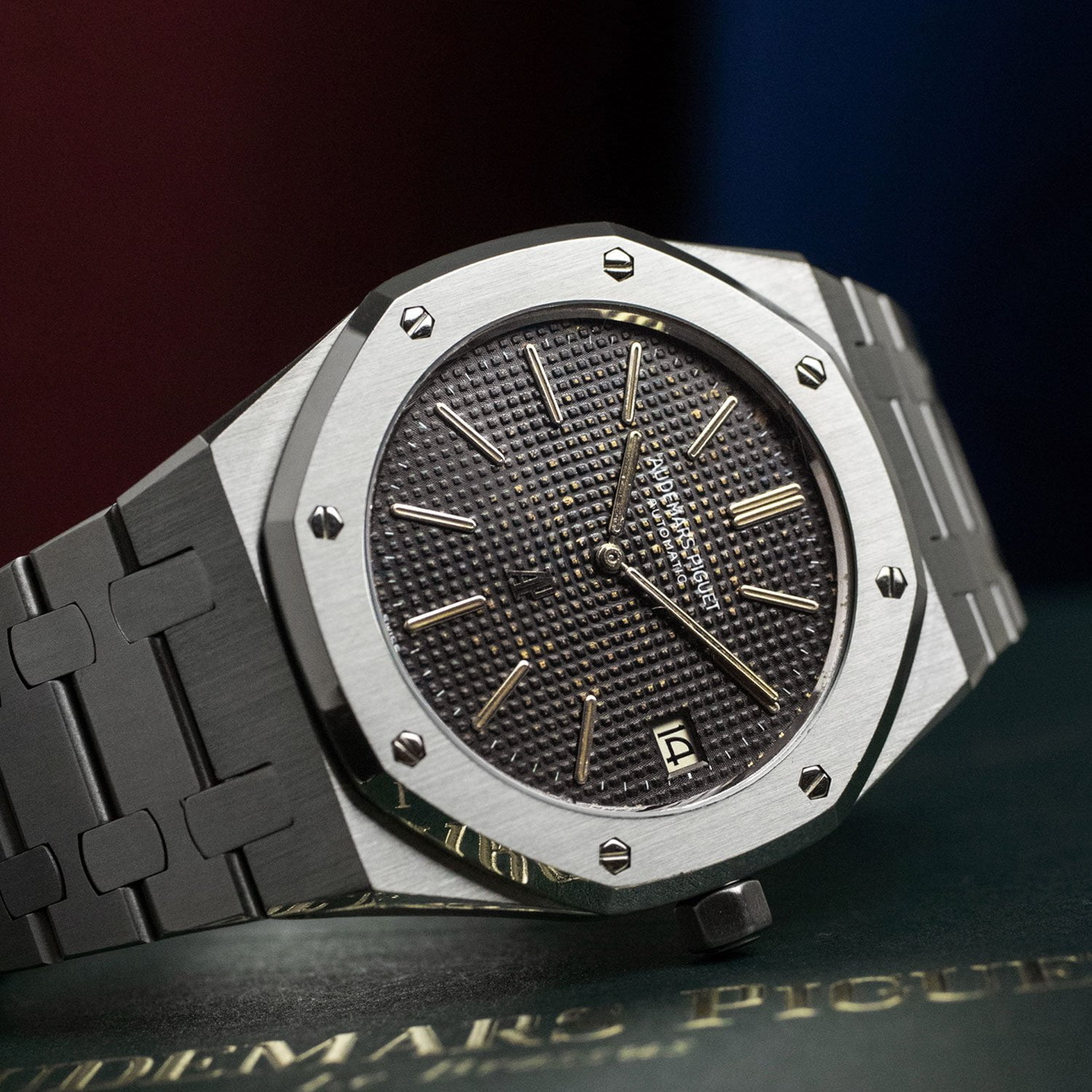

Late 70’s Audemars Piguet introduced different metals for this model. The yellow gold, white gold and bicolour examples are numbered but no letter in front and cases are probably produced in a single batch. 5402BA (18k yellow gold) knows a production volume of 745 pieces, 5402SA (Steel and 18K yellow gold) close to a thousand and for the 5402BC (whitegold) production numbers are unknown but without a doubt is the rarest.
Please note: there is a rare intermediary series of the 5402ST between A and B that has no serial on the caseback. But beware, it can also lack the number because a caseback has been used for a bicolor 5402; so make sure to examine it closely and/ or have it confirmed by the extract of the archive.
All 5402’s left the factory with an unsigned crown, however, during service they were often replaced by an AP signed crown. Furthermore, the dials ought to have a “Swiss” signature at the bottom of the dial; if it is signed “Swiss made” instead, the dial has been replaced during a service.
The dial color of the steel models is described by AP as black but rather looks blue greyish. This dial is also often seen in the BA, SA & BC. Besides the grey dial one can also find a champagne dial in the yellowgold or bimetal 5402. Overtime Tappiserie dials from this era have the tendency to discolor and turn brownish or goldish, according to some collectors extra valuable.

The most common dials sport baton hour markers, filled with a tritium compound. This luminous material can then also be found in the handset. If the dial is diamond set instead, the hands are thinner and without lume. After 1997 Luminova is most often used on service dials rather than the slightly radioactive tritium.
Besides the dial, the case can also be encrusted with diamonds. Whilst highly unusual, some precious metal examples are known with a diamond-set bezel and even more unlikely with diamonds on the bracelet.
Other rare pieces are retailer stamped with Tiffany & Co. or Chaumet for example. There is one example known without the Tappiserie pattern on the dial but smooth surface instead. This 5402 with diamond markers is believed to be issued by the Sultan of Oman and is adorned with the Khanjar crest at the 6 o’clock position. White dials have also been a subject of discussion, but none have ever been confirmed for this reference.
14802
The next chapter starts in 1992, 20 years after the introduction of the Royal Oak and close to 7000 “Jumbo Ultra-thins” later. Approximately 1000 pieces of this “Jubilee edition” were created: roughly 700 pieces in steel and 300 pieces in yellow gold. The watch is quite similar to its predecessor, yet it proudly displays the movement through its crystal case back, resulting in a slightly thicker case.

The dial now reads “Swiss made” at the bottom, and in addition to the regular dial color, the steel one had the option for a Salmon dial. Furthermore at least two examples are known to feature a “Yves Klein blue” dial on request.
By the end of the century 8 prototypes were created out of platinum and were fitted with a patterned blue dial that reminds us of the Tuscan finish. Due to high production cost, they never created the initially intended batch of 125 pieces. Instead, they went on to release the well-know 15202 in that same year.
15002
But before the 15202 was released, there was this often forgotten and underappreciated ref. While not much has been written about the 15002, research indicates that AP made less than 200 of this reference, the majority in steel and around 10% in yellow gold. Like the original model 5402, this has a closed case back. One of the unique features of the 15002 is the case opening where the stem enters the case; which enables the movement to be removed from the case with the stem still attached, the only Royal Oak Jumbo model with this feature. This model saw light in the mid 90’s and stayed pretty true to the classic Royal Oak as it only featured the traditional dial colors.

15128
The 15002 might be rare but doesn’t come close to the obscure 15128, as only 50 Pieces of this Royal Oak were released. This special edition, for the Italian market, was solely produced in steel, and albeit having quite some alternative features it surely belongs in this list. The thing that stands out most are the dials. And I said it in plural since, oddly, they were delivered with 2 dials: one green and one blue. Whilst both the olive green and blue dial remain to display the Tappiserie patern, it is limited to the center. The uncommon Arabic numerals and the AP logo surrounding it are luminous. Last but not least we can find an Arabic minute track, another unicum.

15202
A homage to where it all started came in 2000. But in my opinion the 15002 is way more similar to the original 5402 since the 15202 again features a display case back. Furthermore, during the first decade of production the AP logo sat at the top and there was a white dial option. In 2012, for the 40 year anniversary of the Royal Oak, they moved the logo back to its traditional place. To make it even more “vintage”, AP opted for the double index markers at 12 and a smaller tappiserie patern. But unlike all previous generations from the ”Jumbo Royal Oak Ultra Thin”, they started to color-match the date-wheel to the dial.
This reference was just taken out of production altogether but came in many varieties regarding the dial and materials used. None of them in bicolor, but for the first time the Ultra-thin line has a rose-gold model and one bimetal with titanium and platinum. The last mentioned features a dark-blue degrade dial. This series also has the flashiest Royal Oak; a full diamond set example.

15206 & 15207
The latest chapter of this ongoing success was launched in 2020 with the release of 2 Limited editions. Made for the Japanese market, more specifically for Tokyo retailer Yoshida, 70 pieces are made out of platinum under ref 15206PT and only 30 of the 15207OR (so in pink gold). Not only the diamond markers are uncommon; but most notable is the smooth dial surface instead of the beloved tappiserie.
Conclusion
Half a century ago they took a leap of faith in Le Brassus, and this year they surpassed Patek Philippe for the first time in terms of revenue. Much of that success has to do with the Royal Oak. We are celebrating 50 years of this very special model, undoubtfully one of the most important and influential designs up to date. To emphasize this, Audemars released a new generation of the Royal Oak Jumbo ultra-thin: 16202. To some this might be a new chapter, but in fact they are closing the book as one of the most important specs is no more, quite literally the engine of this whole project. They took 5 years to develop caliber 7121 for it to replace the caliber 2121. With this video we would like to pay tribute to that almighty movement, housed in a Jumbo case, yet being ultra-thin. Cheers to you Royal Oak!